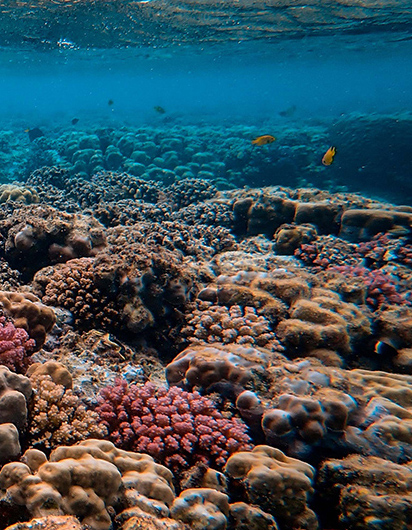RESTORATION
OUR METHODS
- PROPAGATION
- CORAL OUTPLANTING
- GENETIC DIVERSITY
- NATURAL RECOVERY
- ARTIFICIAL REEF
A Natural Mechanism for Regeneration
Coral Reproduction
Coral reproduction is a vital process that relies on various environmental factors. In sexual reproduction, corals gather to release their eggs and sperm into the water, where fertilization occurs collectively during specific times of the year when environmental conditions are optimal. In asexual reproduction, corals can reproduce through fragmentation, where a broken branch can start growing and form a new colony. These processes play a key role in maintaining biodiversity and ensuring the sustainability of coral reefs in the oceans.

FLOATING NURSERIES
We use floating nurseries to grow coral and marine plants in a controlled environment. First, we design floating platforms made of durable materials like PVC. Coral fragments or marine plants are attached to these platforms, which are then placed in selected marine areas with optimal conditions for growth, such as proper depth and temperature.
The platforms are monitored regularly to ensure stable conditions, and the corals and plants are allowed to grow and develop. Once they reach a sufficient size, they are transplanted to damaged reef areas for restoration or used in other conservation projects. This method enables efficient propagation and supports marine ecosystem restoration.

Outplanting Coral
REEF RESTORATION
We use innovative techniques to restore damaged coral reefs through the cultivation of coral in controlled environments like floating nurseries. In these nurseries, coral fragments grow rapidly in nutrient-rich water and sunlight, transforming into large colonies that can be transplanted onto degraded reefs in a short period.
Once the fragments reach the ideal size, they are carefully transported to selected restoration sites. These pieces are securely attached using strong marine adhesives to ensure stability and healthy growth. This process helps restore marine ecosystems, enhance biodiversity, and support marine life in affected areas. Regular monitoring of the planted corals ensures the success and sustainability of the restoration efforts.

GENETIC DIVERSITY
FUTURE PROOFING
In order for restoration efforts to be successful in the long term, it is essential that the corals we outplant are genetically diverse. Our nurseries have a genetic diversity for corals whose populations are in a spiral of decline .
We ensure to have a data base tracking information on almost all of our coral species including genotypes, collection location, phenotypic observations from within our nurseries, locations within nurseries, and genetic sequencing data.

Sexual reproduction
NATURAL RECOVERY
We help at building ex situ nurseries where sexually reproduction the corals. Our out planted coral thickets are now spawning naturally.




